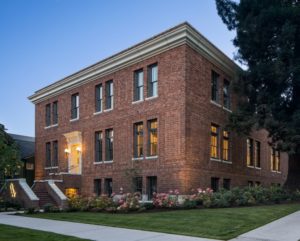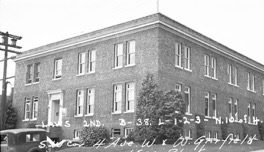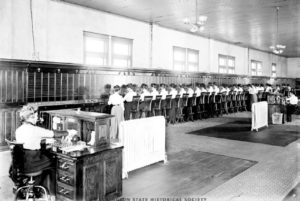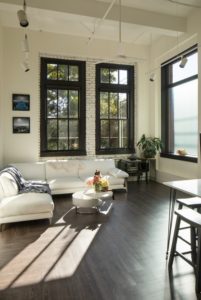For Sale!
Historic Seattle is selling the Egan House.
Historic Seattle is selling the Egan House.
Each year, Historic Seattle honors outstanding people and projects in preservation at our Annual Preservation Celebration. To do this, we need your help!
We want to hear from our entire preservation community about what preservation projects YOU think are worthy of celebrating. The deadline to submit is Friday, May 10.
Historic Seattle’s Annual Preservation Celebration is coming up on September 28, 2023. We’ll celebrate the projects and people that help amplify our mission. Today, we feature the Labour Temple, the 2023 Best Preservation Project Award recipient.
Designated a City Landmark in 2008, the Labour Temple (originally the Seattle Labor Temple) in Belltown (2800 1st Avenue) represents an important aspect of Seattle’s notable labor history as the booming wartime workforce increased the number of local workers and numerous unions that established offices in the vicinity. Constructed by the labor unions in 1942, the building was owned and occupied by them for almost 80 years. An addition to the north (containing an auditorium) was constructed in 1946 and a third story was added to the original two-story building in 1955. The property served as headquarters of the MLK Labor Council and as long-time focal point for union organizing and activities in the county. It was the last large functioning labor hall in Belltown, a neighborhood that was once the center of union activity.
In the last few decades, with the rising costs of real estate, constituents of the labor unions moved farther out of the city and the building took on some deferred maintenance. The Seattle Labor Temple Association considered restoring the building or listing it for sale. They chose the latter; FAUL purchased the original south building in December 2020 and the north addition was sold to a church. The building underwent extensive renovation, welcoming its first office tenants in 2022 and reopening as the rebranded “Labour Temple,” with the “u” signifying the u-shaped building and union history.
The transformation of the former Labor Temple into a modern co-working community hub with common amenities has given the landmark a new lease on life. The rehabilitation included restoration of the brick and terra cotta facade, original steel windows, mahogany office doors and Labor Temple signs; new roof, building systems upgrades, renovated historic lobby and preservation of the private offices and corridors. The courtyard was activated, and a rooftop terrace added, providing outdoor spaces. The building also offers event and meeting spaces and participates in the monthly Belltown Art Walk.
The commitment of the team to preserve and enhance this “working-man’s” office building into a creative co-working space has resulted in the preservation and extension of the useful life of this historic building for the Belltown community. Kudos to project team members: FAUL, Kenneth Wilson Architect, Venture General Contracting, HCMP, DCI Engineers, Berger Partnership, Marian Built, Finishing Touch Masonry, BuildingWork, Region 6 Systems, Net Tech, and Joe Seabeck.
Image courtesy of Evan Parker Photography
Historic Seattle’s Annual Preservation Celebration is coming up on September 28, 2023. We’ll celebrate the projects and people that help amplify our mission. Today, we feature the Attic, the 2023 Preserving Neighborhood Character Award recipient.
In the constantly changing urban streetscapes of Seattle, it’s the places that have been around for decades or more that help shape and maintain the character of a neighborhood. Central to any community are the legacy businesses that we all come to love. These “third places” bring us together. One such place is the Attic Alehouse & Eatery in Madison Park. The Attic has anchored the neighborhood at 4226 E Madison St since 1967, the same year the building was constructed, replacing a much older structure that once housed a bowling alley in 1907, then a shooting range transitioning to a bar in 1937. The Attic abruptly closed in early February 2020 before pandemic-caused closures. The historic bar’s longtime owner of 30 years, Mark Long, passed away in 2018. At this time, an interim ownership group stepped in prior to the current business owners.
Fortunately for Madison Park and Seattle, the Attic has survived as a legacy business and reopened in late April 2023, saved and resurrected by ESR (Ethan Stowell Restaurants) led by Executive Chef Ethan Stowell and Howard Wright, the Founder and CEO of Seattle Hospitality Group (SHG). The new owners purchased the historic watering hole, installed new hardwood floors, and made “facelift” improvements to the space. This new chapter in the long and storied history of the Attic celebrates many memories and great times and continues making new ones.
As described in a recent Seattle Times article, “Under Long’s stewardship, the pub turned into that proverbial third place, where softball teams hung out after league games. Many locals had their first dates there, and families hosted celebration of life events.” According to Stowell, “In the last 50 years, tons of parents have taken their kids here for their first beer. Watch Cougar and Husky games. This is like the neighborhood ‘Cheers.’”
The continuation of the Attic gives us hope because Seattle has lost and continues to lose so many legacy businesses. It’s these words by Ethan Stowell that caught Historic Seattle’s attention and why we honor the Attic with a Preserving Neighborhood Character Award, “It is a preservation thing,” Stowell told the Seattle Times. “We would like to see other neighborhood institutions continue on. If we can help with that, we would be happy to take that on.”
To that we say, “More please!”
Image courtesy of the Attic
Historic Seattle’s Annual Preservation Celebration is coming up on September 28, 2023. We’ll celebrate the projects and people that help amplify our mission. Today, we feature one of two recipients for the Beth Chave Award for Preservation Champion–Clay Eals.
Clay Eals is a pied piper of preservation in Seattle.
In 1989, he spearheaded landmarking of the Admiral Theater in West Seattle, saving it from demolition and redevelopment. (Check out this news clip from 1989!) In 2016-17, he worked with owners of the Hamm and Campbell buildings in the West Seattle Junction and inspired the community while securing landmark designation of these two crown jewels of the business district. He also was instrumental in saving the landmark Alki Homestead, a unique log structure built in 1904. He is working with other advocates to Save the Stone Cottage in West Seattle.
While Clay is a preservation champion, he also is many other things.
Born July 21, 1951, Clay lives in West Seattle and has devoted his adult life to writing and publications. He worked 15 years as an editor, reporter, and photographer for four Pacific Northwest newspapers, two years as a journalism teacher, 13 years as a curriculum writer and publications editor for Fred Hutchinson Cancer Research Center and five years as communication officer for the Encompass children’s organization. He also wrote and had published biographies of child actress Karolyn Grimes (Zuzu in “It’s a Wonderful Life”) and singer-songwriter Steve Goodman (“City of New Orleans”).
Before working nearly five years as the first executive director for the Southwest Seattle Historical Society, he was a founding member in 1984, serving on its board for 12 years and as its president for three.
With a passionate and enthusiastic approach, Clay loves to elevate stories of local people and places. In 1987, he edited, designed and partly wrote a 288-page history of West Seattle and White Center, “West Side Story,” published by Robinson Newspapers. Since 2019, he has prepared, with Jean Sherrard, the weekly photo-history column “Now & Then” for Pacific NW magazine of The Seattle Times. Their column continues the 37-year tradition of its founder, Paul Dorpat. Clay often seeks “Now & Then” subjects that reveal why preserving historic places is vital.
As Clay told the West Seattle Blog: “It’s all about identifying and saving the gems that make us unique so that they can keep functioning and inspiring us all down the road. None of us does preservation work alone. I truly believe in the well-worn phrase ‘It Takes a Village,’ and I’m grateful to know first-hand that many in West Seattle and in the city as a whole are key parts of that village.”
Image: Clay Eals emceeing Pete Seeger’s 90th birthday celebration at the Admiral Theater, 2009; Jean Sherrard, photographer
Historic Seattle’s Annual Preservation Celebration is coming up on September 28, 2023. We’ll celebrate the projects and people that help amplify our mission. Today, we feature SIFF, the 2023 Community Investment Award recipient.
SIFF is the centerpiece of Seattle’s film community. The Seattle International Film Festival is THE event that cinema lovers in the Pacific Northwest look forward to every year. Beyond running one of the world’s largest and most dynamic annual film festivals, SIFF has also fully embedded itself in the Seattle community through year-round events, gatherings, summer filmmaking camps, and more. Most visibly, SIFF has stepped forward time and again to rescue beloved Seattle movie theaters that might otherwise have been demolished or left to collect dust including the Uptown, the Egyptian, and now Cinerama!
For this, Historic Seattle honors SIFF with a Community Investment Award for its work in reopening and maintaining the Cinerama, a cultural icon in Seattle since it opened in January 1963 that operated continuously until its closure in February 2020. For over three years, the theater sat empty with an uncertain future. SIFF announced its acquisition of the Seattle Cinerama Theater from the estate of Paul G. Allen in May 2023 at the opening celebration of its 49th annual film festival. They appreciate the estate’s support and commitment throughout the process. The Cinerama has offered one of the city’s most unique great movie theater experiences since its inception. Representing a significant part of American film history, it is notable as one of only two remaining Super Cinerama theaters, and one of only three capable of showing the original Cinerama three-strip films. When the Cinerama reopens later this year, it will be under a new name due to trademark issues, but in SIFF’s hands, the experience will be just as we remember. The theater’s programming will be similar to previous Cinerama programming, blockbuster studio films, specialty festivals and events, and first-run arthouse films.
With LA’s Cinerama Dome currently out of use, SIFF’s decision to buy and invest in the theater’s future is not only important to Seattle but also on a national and global scale. However, what truly makes SIFF’s purchase so special is that it ensures the long-term survival of a beloved downtown venue full of cherished moviegoing memories for generations of Seattleites. Now, thanks to SIFF and its generous supporters, future generations will get to make their own wonderful memories at Cinerama. With its purchase of Cinerama SIFF has proven once again that it is here to serve Seattle no matter what, not only as part of the city’s film community, but also the community as a whole.
Image courtesy of SIFF
Historic Seattle’s Annual Preservation Celebration is coming up on September 28, 2023. We’ll celebrate the projects and people that help amplify our mission. Today, we feature one of two recipients for the Beth Chave Award for Preservation Champion–Dr. Dorothy Laigo Cordova.
The Beth Chave Award for Preservation Champion goes to Dr. Dorothy Laigo Cordova, or “Auntie Dorothy,” as she is affectionately known, for her outstanding life-long contributions to the preservation of Filipino Americans’ rich history and cultural heritage. Born in Seattle in 1932, she grew up here feeling unaccepted as American and saw her Filipino heritage being systematically erased, even in immigrant communities.
Auntie Dorothy met her husband, the late Dr. Fred Cordova, while studying Sociology at Seattle University. They cofounded the Filipino Youth Activities (FYA) in 1957 to promote healthy activity options to youths in Seattle, including their own eight children. Dorothy and the FYA advocated for civil rights, especially for immigrants and refugees, helping to connect them to employment and other services. In the 1970s, as Executive Director of the Demonstration Project for Asian Americans (DPAA), Dorothy conducted pathbreaking sociological and historical research that focused on Korean Americans and Filipino Americans.
Frustrated by the dearth of information and inaccurate portrayals about Filipino American history, Dorothy founded the Filipino American National Historical Society (FANHS) in 1982 and has volunteered as FANHS’ unsalaried Executive Director since then. Its mission is “to promote understanding, education, enlightenment, appreciation and enrichment through the identification, gathering, preservation and dissemination of the history and culture of Filipino Americans in the United States.”
Under her leadership, and with Fred as Founding President, FANHS established the National Pinoy Archives housed with the FANHS National Office located inside the historic Immaculate Conception Church in the Central District. It is one of the largest collections of Filipino American historic photographs, oral histories, recordings, exhibits, ephemera, and material artifacts in the world. FANHS also designated the nationwide observance of October as Filipino American History Month. Since 1987, FANHS has been sponsoring biennial national conferences in different cities, gathering hundreds to learn about Filipino American history, with the most recent conference in 2022 held in Seattle.
Dorothy and FANHS have been serving as the Principal Investigator for the Washington State Department of Archaeology and Historic Preservation’s effort to identify, document, and commemorate the rich contributions of Filipino Americans to the state’s history.
Although she announced her intention to retire from FANHS in 2024, to transition to “Resident Researcher,” now, at 91-years-young, Auntie Dorothy can still be found at the FANHS National Office every day, answering phone calls and email inquiries, giving interviews, hosting students, sharing photographs, talking story, and documenting the layered history of Filipino Americans.
Image of Dr. Dorothy L. Cordova researching collection at FANHS, courtesy of Clay Eals (August 2023).
Historic Seattle’s Annual Preservation Celebration is coming up on September 28, 2023. We’ll celebrate the projects and people that help amplify our mission. Today, we feature the Community Advocacy Award recipient, Historic Wallingford.
Founded in 2017, Historic Wallingford is a grassroots organization that fosters awareness and appreciation of Wallingford’s heritage through education, publications, and community activities. The nonprofit organization has done a remarkable job of celebrating and sharing the history and architecture of the Wallingford neighborhood in just six short years. Historic Wallingford has been instrumental in creating a historic district, organizing walking tours, hosting educational events, and advocating for the protection of historic buildings and landmarks. It is a shining example of how local groups can make a positive difference in preserving the past, celebrating the present, and shaping the future of their neighborhoods.
Historic Wallingford’s recent effort to sponsor the successful listing of the Wallingford-Meridian Streetcar Historic District to the National Register of Historic Places is a notable achievement in the organization’s short history. Beginning in 2019, Historic Wallingford hired Northwest Vernacular to conduct a feasibility study (with grant support from 4Culture) on potentially qualifying areas in the Wallingford neighborhood for a National Register historic district. To aid in this effort, volunteers were trained to survey the neighborhood and conduct archival research. The organization conducted fundraising via direct mail and support from 4Culture. After three years and over 2,000 volunteer hours by Historic Wallingford board members and volunteers, with the skillful completion of the nomination by Northwest Vernacular, the area which subsequently became known as the Wallingford-Meridian Streetcar Historic District was placed on the National Register of Historic Places on December 9, 2022. The district showcases the development of streetcar transportation in Seattle, as well as the architectural and social diversity of the neighborhood areas along the historic routes. The district benefits the residents, visitors, businesses, and environment by providing a sense of place, identity, and pride, as well as promoting walkability and building maintenance.
Historic Wallingford continues to advocate for its community, promoting the historic district, publicizing the value of the historic architecture, and collaborating with local businesses to produce self-guided activity brochures—”Exploring Wallingford” and “Where in Wallingford?” This year, the organization celebrates Wallingford with a second self-guided tour brochure, a locally focused live radio show at the farmers market with Feliks Banel, and neighborhood beautification efforts such as Earth Day cleanup and historically themed utility box wraps.
Historic Wallingford exemplifies community and preservation. We honor them with the 2023 Community Advocacy Award!
Image courtesy of Historic Wallingford – street signs at N 45th St and Wallingford Ave N
Historic Seattle’s Annual Preservation Celebration is coming up on September 28, 2023. We’ll celebrate the projects and people that help amplify our mission. Today, we feature the Outstanding Stewardship Award recipient, Byrd Barr Place.
Byrd Barr Place is a community action agency supporting the diverse Central District neighborhood of Seattle with housing and energy assistance, a food bank called The Market which utilizes the client choice model that centers community as they are called upon to choose their items like a typical market as well as offering financial education for residents. The organization is named after Roberta Byrd Barr, a community leader, educator, and journalist who became a passionate advocate, elevating the voices of the Black community and the marginalized.
The old Firehouse #23 was built in 1908, is listed in the National Register of Historic Places, and is a Seattle Landmark. The building was leased to the Central Area Motivation Program (CAMP) in the 1960s, giving a place to an important social organization formed by Seattle’s Black community to alleviate poverty and racial inequality in the Central District. Today, the organization continues to serve the neighborhood and Seattle’s urban core, last year completing its first major firehouse remodel since its original renovation to a community center in 1970.
The design approach affirms history, place, and service to the community, re-shaping the interior to meet changing needs while respecting its historic character. The renovation reconfigured the interior for a daylit market, a community meeting space, a generous reception area, and flexible office spaces for staff, allowing Byrd Barr Place to serve people more effectively. Firehouse #23 is a welcoming, accessible, and effective community-centered place to pursue Byrd Barr Place’s continued efforts to center Black voices in the decision-making for Black-bodied people. Improved building systems increase energy efficiency and decrease the building’s carbon footprint. New site-specific art supports Byrd Barr Place’s continuing contribution to Seattle’s Black population. The redesigned Market enhances customers’ experiences, increases food distribution capabilities, and promotes health and well-being. Reflecting her legacy with the organization, a wall mural illustrates the life of Roberta Byrd Barr. The project preserves a unique cultural asset for Seattle’s Black community and modernizes the 115-year-old building to expand social services and engagement.
The building renovation represents outstanding stewardship of a historic and cultural resource, revealing and accentuating the building’s original structure while providing for new programs and equitable public circulation.
Congratulations to project team members: Byrd Barr Place (owner), Pacific Program Management, SHKS Architects, Rafn Company, Lund Opsahl, FSi Engineers, Travis Fitzmaurice Wartelle Balangue Engineers, SparkLab Lighting Design, Coterra Engineering, Wetherholt & Associates, SiteWorkshop, PanGEO, Inc., Rafael Soldi Photography, and Zorn Taylor Photography.
Photo credit: Rafael Soldi Photography
In Seattle, there is often tension between preservationists and developers; a conflict between saving existing buildings and serving the needs of the community, specifically with places for more people to work and live. Queen Anne Exchange reconciles two divergent goals: through the adaptive reuse of a landmarked neighborhood building, it transforms a structure used as a storage facility for over five decades into 25 apartments in highly desirable Queen Anne.

The building now known as Queen Anne Exchange was constructed in 1921 as a two-story telephone switchboard operation facility for the Pacific Telephone & Telegraph Company. In 1929 a third floor was added with plans to expand to a fourth floor if necessary. According to the landmark nomination, the building facades express a “restrained neo-classicism” with vertically proportioned windows and a primary entrance on the east façade. The primary façades are clad in brick with wire cut, rug-faced texture and variegated buff to reddish-orange colors, and off-white glazed terracotta trim with “fine Greco-Roman detailing.” The terra cotta elements frame the main entrance and are used at the windowsills and at the exterior stair copings.


The building was donated to the Seattle Public Library in the 1970s and was remodeled in 1977 to serve as a materials distribution hub. As a structure intended for staff purposes only and not open to the public, this remodel served to stabilize the building and make it more functional for storage needs. The original sheet metal cornice, assumed to be in an unsafe state of disrepair, was removed and replaced with a flat band of light-grey exposed aggregate stucco.
The adaptive reuse of Queen Anne Exchange included the following elements: replacement and restoration of three window openings in the brick façade; restoration and preservation of the exterior brick and terra cotta façade; reconstruction and replacement of the original cornice; replacement of a glazed main entry door and sidelight; infill of a portion of the interior courtyard with a small addition housing a new elevator, exit stair, and shear walls; new fourth-floor addition only minimally visible from the street; new vehicle ramp and new garage entry to the lower level; and enlargement of six windows to create viable residential units at the lower level.

Both the site and building exterior were designated as a Seattle landmark in 2015, providing an opportunity to create a land use pathway for the structure to be redeveloped into multifamily housing, a use not typically allowed by the site’s SF 5000 zoning designation. Queen Anne Exchange provides an example of how, through creative design and a belief in an existing building’s potential, the preservation and re-use of existing buildings, especially those with long histories and a strong physical presence, can align with Seattle’s need for increased density and affordable housing. With this completed project, a precedent has been set for an ongoing win/win scenario.
Congratulations to Faul, LLC and the entire project team, winner of the 2022 Best Preservation Project Award!
Project Team:
Owner/Design: FAUL, LLC
Architect: BuildingWork
Interior Design: Graham Baba Architects
Structural Engineer: Coughlin Porter Lundeen
Civil Engineer: SiteWise Design
Landscape Architect: Karen Kiest Landscape Architects
Contractor: Venture Construction
Bank: Umpqua Bank